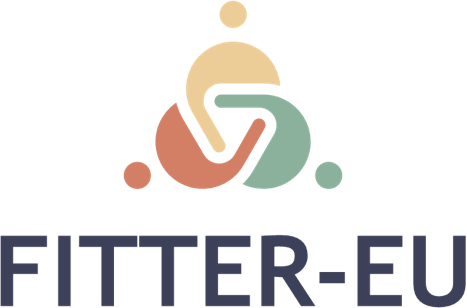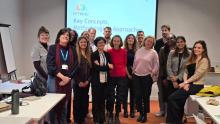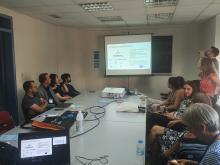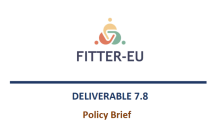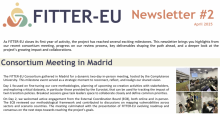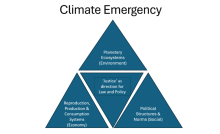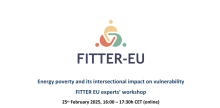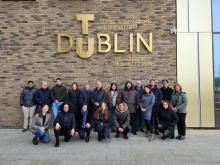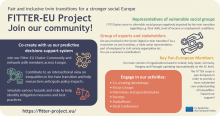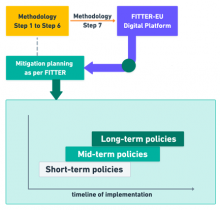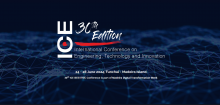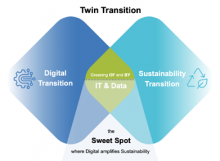Strategies for Sustainable Digital Solutions to support Vulnerable Communities in the context of the Twin Transition

Introduction
Inclusive sustainability for vulnerable communities in the context of the twin transition necessitates a holistic approach that considers socio-economic disparities, cultural sensitivities, and accessibility barriers. By actively involving marginalized social groups in the design, implementation, and governance of digital initiatives, stakeholders can foster empowerment, resilience, and social cohesion. Strategies for inclusive sustainability must bridge the digital divide, enhance digital literacy, and promote participatory decision-making processes, while addressing systemic inequalities and promoting social justice. By prioritizing the needs and voices of vulnerable communities and embracing sustainability principles, societies can leverage digital technologies to create a more resilient, equitable, and sustainable future for all.
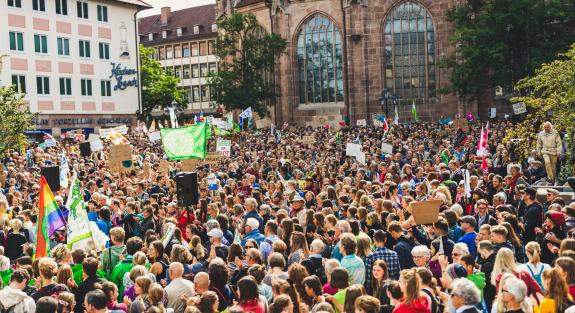
Relevant Challenges in the context of Twin Transition
Based on the analysis of recent research and European Union’s initiatives, some core challenges accompanying the twin transition process can be allocated [1, 2]:
- Technical Challenges: These relate to the development, deployment, and integration of digital and green technologies, as well as to the integration of technologies and approaches of different generations. For instance, the building and deployment of new green power facilities should be supported by the distribution infrastructure, as well as digital platforms enabling monitoring and demand-tracking.
- Policy and Regulatory Challenges: These contain supportive rules and guidelines that incentivize sustainable practices and digital transformation. In other words, there is a need for the development and implementation of appropriate policies that will create conditions for companies and citizens to participate more actively in the twin transition process.
- Social Challenges: The twin transition needs to be inclusive and equitable. This presumes minimization of social disparities and inequalities, ensuring a fair access to technologies and infrastructure for different social groups, and mitigating negative impacts caused by labor market transformations.
- Economic Challenges: These include the needed costs for the transition, to ensure competitiveness on a national and international scale. Furthermore, investment initiatives should aim at striking a balance between the aspiration for short-term investments and long-time period sustainability targets.
- Environmental Challenges: These are mainly focused on mitigating environmental impacts, selling sustainability, and making sure that the transition contributes to the renovation and recuperation of our planet.
Solutions to Foster the Twin Transition
There are some vivid examples of solutions that can be used to foster the twin transition process. The first example, encompassing an important area of digital literacy training, is to foster digital literacy by both technological measures (e.g. digital platforms offering courses addressing digital literacy), and curricular measures (e.g. developing new courses including those that discuss the importance of digital technologies and their role in twin transition). A vivid illustration of the mentioned example is the YachaY initiative [3], which enables the establishment of a personalized curriculum adapted to the personal and industrial learning needs about new technologies in the context of twin transition, providing students with personalized, inclusive and flexible education. A second example is the digitalization of some services offered by public authorities – e.g., a digital citizen office, where a person can create an account, and login using a kind of “digital pass”. The extension of the digitalization of government services can be beneficial, for instance, to vulnerable foreigners / refugees, as the process of getting an appointment at the foreign office can often be challenging given that digital appointment bookings are not always available and in non-English speaking countries the applicants and employees often don’t speak English.
A third example includes a wide range of collaborative services that can be offered by digital platforms to foster the development of local communities. In small rural communities, there are often a significant number of small or medium farms, which require machines for agricultural activities like harvesting, which in many cases are non-affordable. In this regard, an important mission of the twin transition is to support small and medium farms with technologies and machines. One potential solution, could be digital platforms that offer sharing or short rent of agricultural machines. Moreover, such a platform could enable networking – for instance, if one farmer has machine X but needs a machine Y for a short time, and another farmer possesses machine Y and needs machine X for a short period of time. Another potential digital solution can provide information about local markets selling the local products, contributing both to the local community prosperity and to conscious consumption.
Some technologies like Blockchain can provide extended capabilities to already existing solutions. For instance, to reward a user that contributes to a community in a certain way with digital coins. An example could be a reduced energy consumption of a given household compared to the previous year, so that, if the consumption drops over several years the reward can be increased. Another possible example is tree planting, so that for every tree planted, a reward is given. These digital coins can be later spent for some services (sport, culture) such as free visits of the swimming pool or theatre, etc. Blockchain could be also used as a driver for the companies to take a more pro-active position in the twin transition process. This can be accomplished by introducing green ranking systems rewarding companies for actions taken towards the twin transition. An example could be those companies involved in the installation of solar panels or another green energy generating capabilities.
In rural areas, people tend to have lower incomes and often cannot afford the installation of green energy sources for their houses. In this regard, a collaborative effort from business and policy makers can change the situation. Thus, the company may install the solar panels, whereas getting their expenses partially covered by government, as well as enabling discounts and instalment payments for the end users. At the end, everyone will profit: end users pay less, the company creates a good image and collects ranking points and the environment benefits from less fossil energy usage.
Conclusion
In the context of the ongoing twin transition, social inequalities that might be sharpened by this process should not be ignored. Innovations alone are not enough if only a small group of people and companies will be able to afford these. This might create additional tensions in society, as the living conditions of vulnerable social groups worsened. In this regard, inclusive sustainability becomes a significant factor in the success of the twin transition. Inclusiveness should be supported by different stakeholders including both for-profit organisations and governmental entities. FITTER will analyse the strategies and technological solutions to enable a sustainable path for the twin transition process.
References
[1] European Commission, Joint Research Centre, Muench, S., Stoermer, E., Jensen, K. et al., Towards a green & digital future – Key requirements for successful twin transitions in the European Union, Publications Office of the European Union, 2022, https://data.europa.eu/doi/10.2760/977331.
[2] Bianchini, S., Damioli, G. & Ghisetti, C. The environmental effects of the “twin” green and digital transition in European regions. Environ Resource Econ 84, 877–918 (2023). https://doi.org/10.1007/s10640-022-00741-7.
